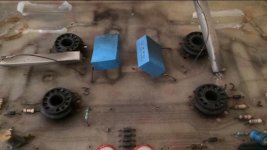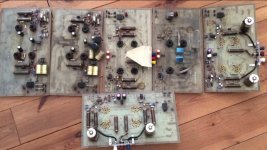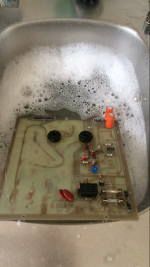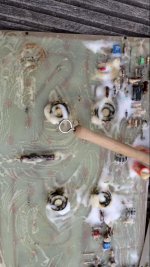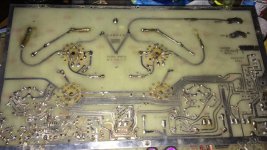First time poster but long time reader here. I own a pair of 2MH (hybrids) with the MK-131 interface, purchased new in 1982. As a testament to the durability of the panels, they all still work fine (well except for one panel but that is another issue). My question concerns the C-Mod. I’ve noted that Andy has recommended it for the MK-131 and MK-141 (see post #1853), even though it was designed for the MK-121. After purchasing the parts, I got to thinking about the component and circuit changes, and how they might affect the low frequency response of the hybrid models which use a single transformer. I think the 2MH’s roll off their panels below about 150 Hz by design. I’m not sure how much of the roll off is due to the stock HP filter using 230uF of capacitance (which is partially shunted by the HF control in the original circuit) and how much is the transformer and other factors. In any case, doesn’t dropping the capacitance on the input circuit to 57uF and changing it to a more standard single pole RC HP increase the roll-off frequency rather dramatically?
I was planning to check the frequency response after the mod but now I’m reluctant to even mess with the circuit until I understand better what to expect. I’d appreciate any comments from knowledgeable posters, especially anyone who has tried the mod on a MK-131 or MK-141.
I was planning to check the frequency response after the mod but now I’m reluctant to even mess with the circuit until I understand better what to expect. I’d appreciate any comments from knowledgeable posters, especially anyone who has tried the mod on a MK-131 or MK-141.
When performing the C-Modification, you are not changing only the value of the capacitor. The resistive network that feeds the HF transformer also changes, which means the total resistance that the capacitor works with also changes. The roll-in frequency of the HF transformer does not change significantly.
A big advantage of the smaller value capacitor is that it's more practical (smaller & cheaper) to change the electrolytic part to a better quality film type.
A big advantage of the smaller value capacitor is that it's more practical (smaller & cheaper) to change the electrolytic part to a better quality film type.
hello group i am in need of a woofer for acoustat 11 it rattles at times anyone have a link to one ?
It would probably be cheaper to have it reconed and it would stay original.
Bill LeGall is the BEST!
Millersound Speaker Refoaming, Speaker Reconing and Repair Services
Bill LeGall is the BEST!
Millersound Speaker Refoaming, Speaker Reconing and Repair Services
I have a, sold only in 2ea pr of the Spectra 11 stock used working 8" bass drivers.....$200.+boxing shipping
Also a 2ea pr used working interfaces...$300"+boxing shipping
Also a 2ea pr used working interfaces...$300"+boxing shipping
I have a pair of Spectra 11 speakers that I can't get the bias up all the way on. I have been working on the interfaces for quite a while. I have performed the update, replaced the high voltage diodes, replaced the caps throughout the board, replaced the high caps... I even replaced the 500M resistor with one that was a OEM part for Acoustat. I swapped the LN13080's from side to side, changed out the 2N2270 transistors for new ones.
I even put deoxit on the trimmer pot to clean it an see if that was the issue.
So I don't know where to go from here. The bias on each interfaces started at around 25 and 45 and now is up to 57 and 70. So I am getting a little bit better with each change. However, now I am out of options. I noticed when short out the 2n2270, the bias goes up drastically. I didn't do that for long.
Is there anything else that I should try? The interfaces have been plugged in for a few days and the bias gone up a little bit but it isn't where it needs to be which is around 75.

I even put deoxit on the trimmer pot to clean it an see if that was the issue.
So I don't know where to go from here. The bias on each interfaces started at around 25 and 45 and now is up to 57 and 70. So I am getting a little bit better with each change. However, now I am out of options. I noticed when short out the 2n2270, the bias goes up drastically. I didn't do that for long.
Is there anything else that I should try? The interfaces have been plugged in for a few days and the bias gone up a little bit but it isn't where it needs to be which is around 75.

When adjusted with output at 57 and 70, measure the DC voltages across the Zener diode, and also between pins 4 & 6 of the 13080 IC on both supplies. This will confirm if input and output voltage levels for the regulator powering the HV oscillator are similar between your two interfaces.
Last edited:
I went thru sorta same hell with my specrtra 11 interfaces...really goofy interface - I eventually pulled and put back in that IC so many times it all the sudden started working...so put a little electrical contact cleaner and then electrical lubricant in that IC socket...
Hmm, I have had them out a few times. I will clean the sockets just to be sure. That is a good idea. I did switch them from side to side with no change.
I didn't get a chance to do the measurements tonight. I will do them tomorrow after cleaning the sockets.
I didn't get a chance to do the measurements tonight. I will do them tomorrow after cleaning the sockets.
Measuring the absolute bias voltage can be tricky, as any method will load down the supply. What method are you using, and what input impedance does your meter have? The point is that your method of measurement may be loading the supply more than usual, and the actual bias voltage may be fine.
Have you tried listening to the speakers...and does the balance between ESL and woofer sound correct? The most important point is that both speakers have the same bias voltage. If the speaker with the lower bias voltage sounds well-balanced, then I suggest you set both speakers for that voltage and enjoy.
Have you tried listening to the speakers...and does the balance between ESL and woofer sound correct? The most important point is that both speakers have the same bias voltage. If the speaker with the lower bias voltage sounds well-balanced, then I suggest you set both speakers for that voltage and enjoy.
Here We Go Again!
This is now the third summer that I've noticed a significant balance problem associated with my 2+2s. Of course, I immediately cleaned the accessible electrical connections, but that hasn't helped. What seems clear is that the problem is in one of my two interface units. I know that because I swapped them between speakers and kept everything else the same. I've had somebody look at that one, but it was clear he was out of his depth; he replaced some stuff but didn't fix the problem. Due to our semi-tropical climate and disdain for A/C, I strongly suspect it's some sort of moisture-related problem that appears in the warm season and dries up when the heat goes on in autumn.
Does anybody have a ghost of an idea what might go wrong (after more than 15 years of regular use) with a 2+2 interface?
This is now the third summer that I've noticed a significant balance problem associated with my 2+2s. Of course, I immediately cleaned the accessible electrical connections, but that hasn't helped. What seems clear is that the problem is in one of my two interface units. I know that because I swapped them between speakers and kept everything else the same. I've had somebody look at that one, but it was clear he was out of his depth; he replaced some stuff but didn't fix the problem. Due to our semi-tropical climate and disdain for A/C, I strongly suspect it's some sort of moisture-related problem that appears in the warm season and dries up when the heat goes on in autumn.
Does anybody have a ghost of an idea what might go wrong (after more than 15 years of regular use) with a 2+2 interface?
Is the PCB dusty or dirty? The high voltage is leaking maybe because of dust mixed with moisture. Cleaning the boards could help...
Some pictures of old Acoustat amps before and after cleaning (some beyond repair).
Attachments
Last edited:
That's an interesting thought! I presume you're talking about cleaning up the interface unit on the back of the under-performing speaker? Can I do that with my Office Depot "Duster" that fires compressed air at my computer keyboard when needed? The whole soap-and-water routine looks a bit scary, plus I'm not sure about taking that sucker apart beyond disconnecting, discharging, and dismounting.
The "high voltage soot" will not blow off with compressed air. If you see an accumulation of black on the printed circuit boards, there are commercial spray-on chemicals specifically designed for cleaning printed circuit boards. You'll probably also need to scrub with a stiff non-metallic brush.
But...a small amount of the "soot" is normal and may not be the issue with your interfaces. I suggest you replace the 5 capacitors in the bias voltage multiplier. These caps may be going off-spec when the humidity is high. And, since these caps don't last forever anyway, I suggest replacing them in both speakers.
Here's one source for replacement capacitors:
Vishay 564R30TSD33 capacitor, 3300 pF, 3000 volts
Mouser p/n 75-564R30TSD33
But...a small amount of the "soot" is normal and may not be the issue with your interfaces. I suggest you replace the 5 capacitors in the bias voltage multiplier. These caps may be going off-spec when the humidity is high. And, since these caps don't last forever anyway, I suggest replacing them in both speakers.
Here's one source for replacement capacitors:
Vishay 564R30TSD33 capacitor, 3300 pF, 3000 volts
Mouser p/n 75-564R30TSD33
hello group i am in need of a woofer for acoustat 11 it rattles at times anyone have a link to one ?
I have a pair that are virtually unused. I bought the 11s new and immediately replaced them with 10” drivers a former Acoustat employee gave me. They’ve been sitting on my closet shelf in a box waiting for a home. I’ll sell both for $40 plus shipping cost.
- Home
- Loudspeakers
- Planars & Exotics
- Acoustat Answer Man is here
